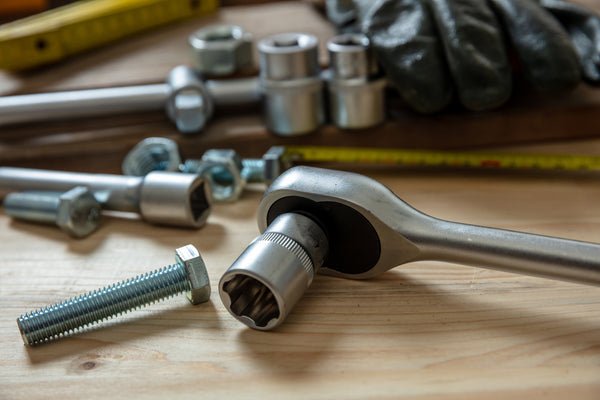How To Use, Choose, And Maintain A Torque Wrench

Jump to:
When it comes to tightening screws, one is always looking for the Goldilocks effect, that is, not too loose and not too tight. If it is too loose, then the thing you are trying to connect with the nut or bolt may become detached over time. Too tight, on the other hand, and it may be difficult to manipulate at a later date and you run the risk of stripping the bolt (see this article for causes of and potential solutions for a stripped bolt). If this is your dilemma, then the torque wrench is your friend.
In this article, we will look at what a torque wrench is, compare it to similar tools such as spanners, discuss the different types of torque wrenches, introduce some products you may be interested in purchasing, describe how to use them, and highlight some points regarding maintenance.
What Is A Torque Wrench?

So, what is a torque wrench and how does it help us to apply the right tightness to a nut or bolt? Torque refers to rotational force and is measured in lb-ft (pound-foot), lb-in (pound-inch), kg-ft (kilograms-foot), kg-cm(kilograms-centimeters), or N-m (Newton meter).
A torque wrench is a tool that applies a specific amount of force, or torque, to a fastening part, such as a bolt or nut. It is usually in the form of a socket wrench (closed socket format) with an indicating scale that provides an indication (such as making a “clicking” sound) when the specified torque value has been reached. By setting a fixed value, an exact level of tightness can be set, rather than relying on the flawed intuition of the user. This eliminates the guess work in determining how tight it should be.
When Is A Wrench Not A Wrench?
Before we go any further, it is probably best to clear up a difference in the way the word “wrench” is used in America and the U.K. The answer to the riddle posed in the title of this section is, “When it is a spanner in the U.K.” Basically speaking, in America, a “spanner wrench” is just like a lever with a hook on it. In the U.K, however, a spanner refers to any such fixed, size-specific tool, and only the adjustable types are referred to as wrenches. Fortunately for our purposes, a torque wrench is a torque wrench everywhere, so there should be no confusion.
Different Types Of Torque Wrench
As previously described, a torque wrench is an instrument that provides a predetermined amount of pressure and torque to various fasteners, including bolts and nuts. This enables it to provide the right amount of tension while avoiding the risk of over-tightening. There are a wide variety of torque wrenches to choose from, depending on your budget and needs, and we shall discuss a few of these below, explaining the advantages and disadvantages of each.
Beam-Style Torque Wrench

This type consists of a head where the socket mounts, which is connected to two beams: the top one which has a pointer attached to it, and the bottom one which acts as the handle and also has the gauge on it. After attaching the socket to the fastener in question, you then bend the bottom arm until the it hits the required torque on the gauge. Being such a simple design, there are fewer parts to wear out and you are likely to be able to use it for a long time without calibration. This may be the least expensive of any of the options, but also possibly the least accurate.
Click Torque Wrench

This is the most common type of torque wrench. It includes a spring-loaded lever which is adjusted by twisting the handle to the correct setting. It them makes a clicking sound when the correct amount of torque is reached (as a result of the lever breaking). While more expensive than a beam-style torque wrench, it is considerably cheaper than digital torque wrenches (described below), and once you know how to set them, are accurate and reliable.
However, they do come with certain drawbacks. If you are new to torque wrenches, it may take a while to learn how to set the torque correctly. Additionally, the scale printed on the side of the wrench may be difficult to read in the dark. There is also an additional step required with click-style torque wrenches when completing each job. Unless you zero out the torque wrench (return the settings to zero) after use, you will stress out the spring inside and this will throw off the calibration.
If you are interested in buying a click torque wrench, you should definitely check out the following two options. The Tohnichi Click-Type Ratcheting Torque Wrench comes in ten sizes, with a solid, durable design, and tightens bolts to a preset torque based on the size of the wrench. If you have a slightly higher budget and need motorsport vehicle-level accuracy, this Motor Sports Wrench, also from Tohnichi, may be the one for you. This click-type torque wrench is capable of tightening fasteners to a preset torque anywhere between 10 Nm and 70 Nm.
Digital Torque Wrench

While it is certainly the case that, with a digital torque wrench, you take a price hit compared to click-type torque wrenches, that extra cost undoubtedly buys you ease of setup. You are provided with a digital display showing your torque setting. Adjusting the torque is as simple as pushing the buttons up and down. The digital wrenches usually come with an LED, a beeper, and a vibrating handle to indicate when you’ve hit the correct torque when tightening the fastener. As it is easy to set up and is clearly visible in the dark, this solves the first two disadvantages of the click torque wrench in one fell swoop. Another advantage is versatility. The digital torque wrench will normally be able to measure torque in all of the five units of measure described above.
In terms of the drawbacks, in addition to the higher purchase cost, you will need to replace the batteries as needed.
Basically, the question of what torque wrench you should choose depends on your budget and how much versatility you need.
How To Use A Torque Wrench

This section provides a step-by-step guide on how to use the different types of torque wrenches. Let’s start with the most common type, the click torque wrench.
How to use a Click Torque Wrench
The following are the steps required for using a click torque wrench.
- Look up the required torque for the fastener (nut or bolt) you are using including the unit of measurement (e.g. lb-ft, nm).
- Face the wrench in a direction in which it shows the desired unit of measurement.
- Twist the base of the wrench up until it lines up with the desired torque setting on the handle.
- Attach the socket head to the fastener.
- Tighten the bolt until you hear a click.
- Remove the socket from the fastener
How to use a Digital Torque Wrench
If you are using a digital torque wrench, on the other hand, you should take the following steps.
- Press the on switch to turn on the digital torque wrench.
- Look up the required torque for the fastener and select the unit of measurement.
- Set the desired torque. There may also be a tolerance setting determines how far below the desired setting you will be alerted.
- Attach the socket to the fastener.
- Tighten the fastener until the wrench reaches the desired torque.
- You will be alerted by feedback from the wrench (vibration, chime, change in color)
- Remove the socket from the fastener.
How to use a Beam Torque Wrench
This is definitely the simplest type of torque wrench to use.
- Look up the required torque for the fastener
- Attach the socket to the fastener
- Bend the bottom arm until it hits the required torque on the gauge.
- Remove the socket from the fastener.
Maintaining Your Torque Wrench

Click Torque Wrench
If you have a click torque wrench, store it in a dry, clean area, being sure to remove and dirt or contaminants from the wrench’s surface with a dry cloth after use, and regularly lubricate the ratchet.
It is also important to wind down the wrench to its lowest torque setting on the scale, which will decrease any tension on the spring.
The wrench will also need to be calibrated by your manufacturer or a reputable calibration service every year or 5,000 cycles, whichever comes first.
Digital Torque Wrench
If you are using a digital torque wrench, when you have finished using it for the day, set the torque to its lowest setting and turn it off. Remove any dirt or moisture (which can cause corrosion) with a dry cloth.
Store your wrench in a hard case to protect it from external impact, and store in a low-humidity environment away from direct sunlight. As in the case of a click torque wrench, have it calibrated the earlier of every year or 5,000 cycles.
Beam Torque Wrench
In terms of cleaning and storage, the same applies to the beam torque wrench as for the other two types described above.
An advantage of the beam torque wrench, however, is that you can check for yourself whether it is calibrated yourself, and perform basic calibration on your own. To check the state of its calibration, inspect the pointer when the tool is at rest. It if pointing at zero, the tool is calibrated. If it is off zero, simply bend the pointer shaft until it points to zero.
The Torque Wrench – A “Must-Have” For Your Toolbox
In conclusion, a torque wrench is an essential addition to any toolbox, ensuring the right level of tightness for all of your fasteners. Whether you opt for the simplicity and ease of maintenance of a beam torque wrench, the accuracy and reliability of a click torque wrench, or the advanced features and ease of use of a digital torque wrench, purchasing a torque wrench is a smart investment that will enhance the quality and reliability of your work, making it a must-have tool for both professionals and DIY enthusiasts.

0 comments